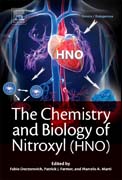
The Chemistry and Biology of Nitroxyl (HNO)
Doctorovich, Fabio
Farmer, Patrick
Marti, Marcelo A.
The Chemistry and Biology of Nitroxyl (HNO) provides the first-of-its-kind coverage of this biologically active molecule with a focus on the study of nitroxyl, also known as azanone per IUPAC nomenclature which has been traditionally elusive due to its intrinsically high reactivity. This comprehensive resource presents the scientific basis to understand the chemistry, along with the technical aspects, of working with the compound. By building on two decades of nitric oxide and nitroxyl research, this book is an indispensable guide for investigators across a wide variety of areas of chemistry (inorganic, organic, organometallic, biochemistry, physical, and analytical), biology (molecular, cellular, physiological, and enzymology), pharmacy, and medicine. Through a comprehensive examination that begins by exploring the unique molecule's structure and reactivity, including important reactions with small molecules, thiols, porphyrins, and key proteins, and then discussing sources of nitroxyl, this useful resource explores both methods for trapping as well as detecting nitroxyl via spectroscopy, electrochemistry, and fluorescent inorganic cellular probing. Expanding on the compound's foundational chemistry, this book then explores its molecular physiology to offer insight into its biological implications, pharmacological effects, and practical issues. Presents the first book on HNO (Nitroxyl or Azanone), an increasingly important molecule in biochemistry and pharmaceutical researchProvides a valuable coverage of HNO's chemical structure and significant reactions, including practical guidance on working with this highly reactive moleculeContains high quality content from recognized experts in both industry and academia INDICE: Part I: The chemistry of Azanone: structure and reactivity 1. HNO as a reaction intermediate Reactions involving HNO with. 2. Small molecules 3. Thiols 4. Porphyrins 5. HNO adducts with heme proteins and mutants Other proteins 6. Non-heme HNO complexes 7. Computations on HNO chemistry/structures -- Spin states and protonation equilibria HNO sources 8. Trioxodinitrate and NONOates 9. The family of Piloty's acid derivatives HNO trapping and detection 10. In cell azanone detection using fluorescent inorganic probes 11. Phosphines as HNO traps 12. Electrochemical detection 13. HNO detection by MS and FTIR Part II: Azanone in biology: pharmacology, toxicology and physiology Molecular physiology of azanone 14. Is azanone endogenously produced in mammals? 15. HNO as an oxygen substitute in flavonol dioxygenases 16. Effects of HNO on Soluble Guanylate Cyclase Activity or Reactions involving HNO with non-heme proteins Pharmacology and toxicology 17. Pharmacological effects of Azanone Part III: Practical issues for working with azanone 18. Use of azanone donors 19. Detection and quantification of azanone 20. Estimating HNO fluxes using global kinetic fitting and singular value decomposition
- ISBN: 978-0-12-800934-5
- Editorial: Elsevier
- Encuadernacion: Cartoné
- Páginas: 370
- Fecha Publicación: 01/07/2016
- Nº Volúmenes: 1
- Idioma: Inglés
